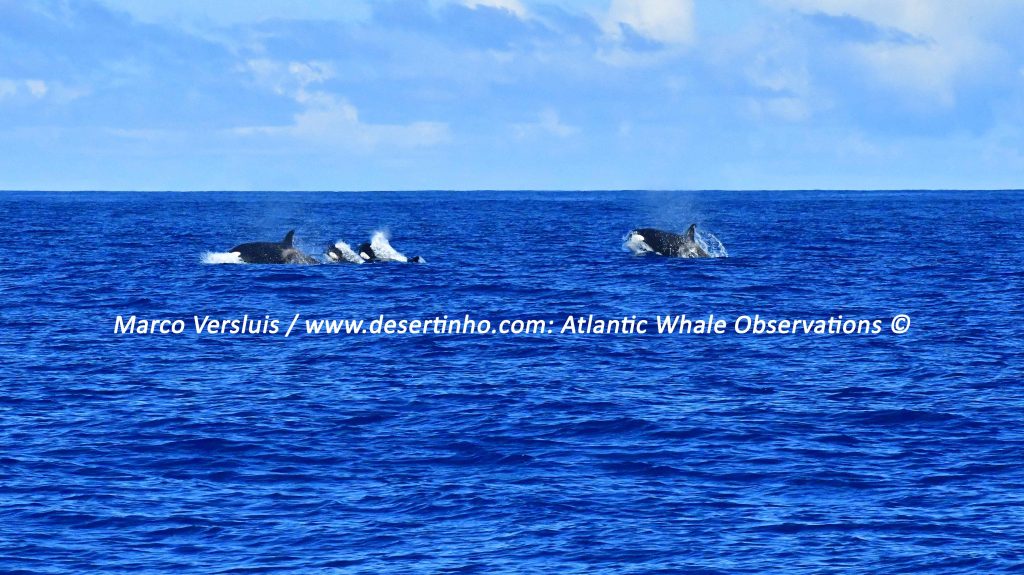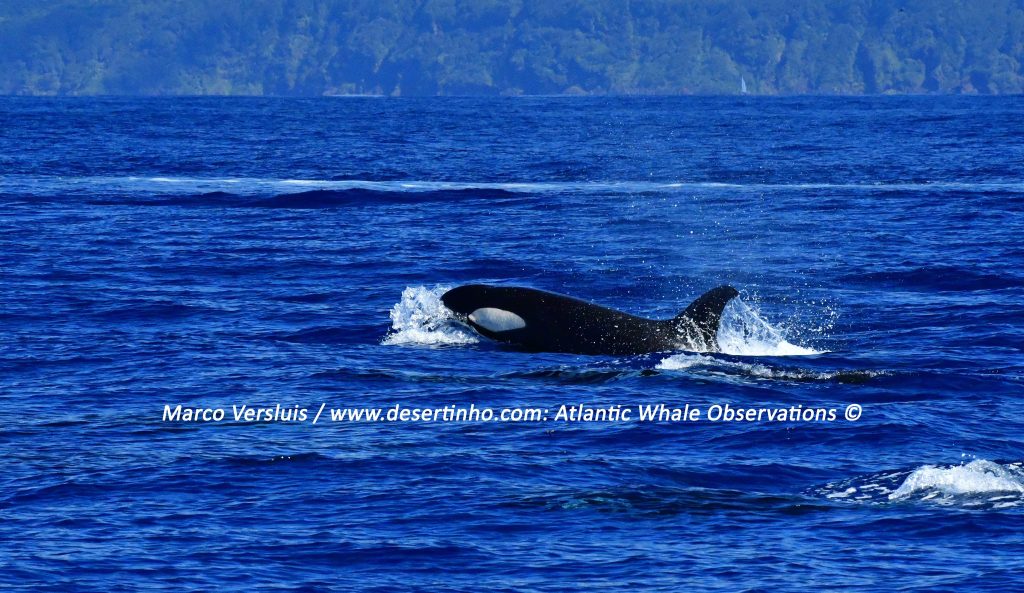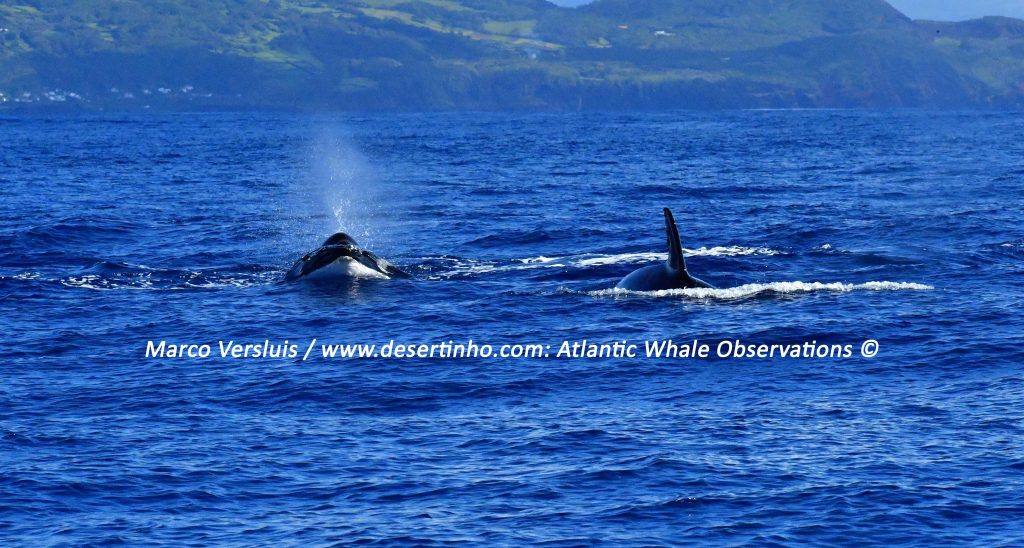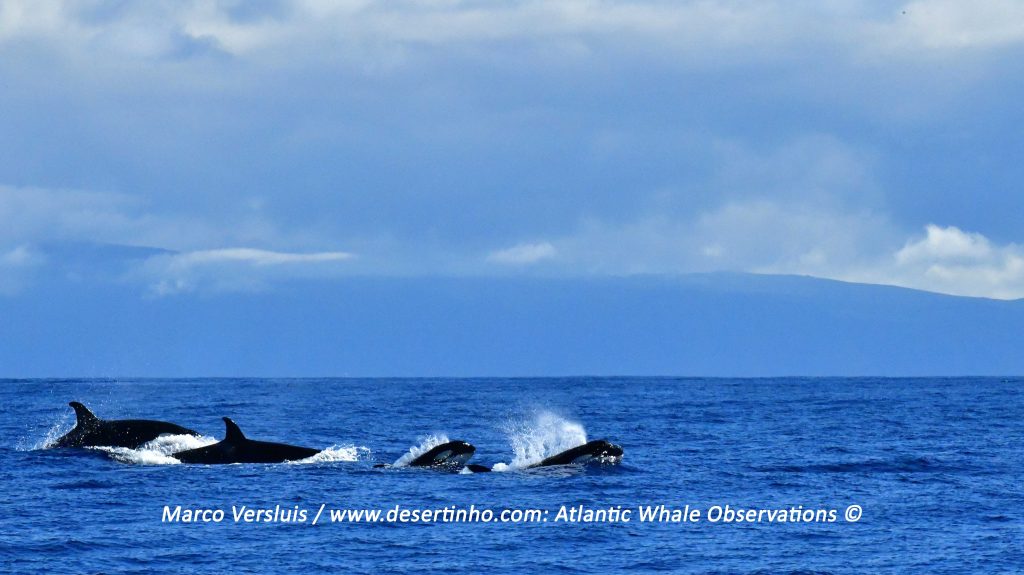The Orca is the largest whale species of the dolphin family. The Orca (Orcinus orca) is the Apex predator of all Oceans worldwide and divided into 9 sub-species. An Apex predator means that an animal has no natural enemies and is at the top of the food chain. The biggest threat to an Orca are humans and the influence humans have on life in the Oceans in general. Because the Orca is an Apex predator, it ingests the majority of PCB’s and other chemicals through prey.
An adult male Atlantic Transient East coast Orca (type A) weighs almost 9 tons, an average dorsal fin of 1.5 meters, and an average length of 9 meters. An adult female Atlantic Transient East coast Orca (type A) weighs almost 5 tons, a dorsal fin of approximately 1 meter, and an average length of 5 to 6 meters.
An Orca calf is born with an average length of between 2 and 2.6 meters and weighs approximately between 160 and 180 kg. Birth of young Orcas takes place on average once every 3 to 8 years and they are suckled in between 2 and 3 years. The age varies greatly by sex: male Orcas live an average of 50 to 60 years and female Orcas live between 80 and 90 years. Finally, Orcas have both upper and lower teeth (20 to 24 teeth per jaw).
The Atlantic Transient East coast Orca (type A) has the dorsal fin in the center of the body and this is a relatively small orca species. Behind this dorsal fin there is a saddle patch which is gray and white in color. This species has a relatively small dorsal fin compared to resident Orcas and they have much more wear and tear on their teeth due to their feeding pattern. Food of this Atlantic Transient East coast Orca (type A) mainly consists of: Tuna, dolphin, minke whales (something this species specializes in) and mackerel. This species is often seen near the Strait of Gibraltar, Ireland, Scotland and the Azores.
Orca’s have an extremely fast swimming speed and a very practical round snout. Nothing sticks to this round snout, such as tentacles or various other prey animals. The Atlantic Transient East coast Orca (type A) is a true cosmopolitan. After Risso’s dolphin, the Orca has the largest dorsal fin.
The photos you see on my website were taken in June 2024 near Terceira (Azores). The entire group of Orca’s at that time consisted of 10 Orca’s. 8 females and 2 juveniles. The male Orca’s turned out to be several nautical miles further from the coast than this group on my website. For me personally, this was the first time I have seen these animals in their natural environment and it was very impressive. Especially the speed at which they swim and how little resistance they experience from the water because they are so beautifully streamlined.
Orca’s can swim up to 55 kilometers per hour, which does not make them the fastest whale species because that is the common fin whale with a speed of more than 60 kilometers per hour. Finally, the Atlantic Transient East coast Orca (type A) consists of approximately 400 Killer Whales (2024).






Orka
De Orka is grootse walvissoort van de dolfijnen familie. De Orka (Orcinus orca) is de Apex predator van alle Oceanen wereldwijd en onderverdeeld in 9 sub soorten. Een Apex predator betekend dat een dier geen enkele natuurlijke vijand heeft en aan de top van de voedselketen staat. De grootste bedreiging van de Orka is de mens en de invloed die de mens heeft op het leven in de Oceanen in het algemeen. Omdat de Orka een Apex predator is krijgt hij de meeste hoeveelheid van Pcb’s en chemicaliën binnen via prooidieren.
Een volwassen manlijke Atlantische Transient Oost kust Orka (type A) heeft een gewicht van bijna 9 ton, een rugvin van gemiddeld 1.5 meter, en een gemiddelde lengte van 9 meter. Een volwassen vrouwelijke Atlantische Transient Oost kust Orka (type A) heeft een gewicht van bijna 5 ton, een rugvin van circa 1 meter, en een gemiddelde lengte van 5 tot 6 meter.
Een Orka kalf wordt geboren met een gemiddelde lengte tussen de 2 en 2,6 meter lang en weegt dan ongeveer tussen de 160 en 180 kg. Geboorte van jonge Orka’s vindt gemiddeld plaats eens in de 3 tot 8 jaar en worden ze tussen de 2 en 3 jaar gezoogd. De leeftijd verschild sterk per sekse: manlijke Orka’s worden gemiddeld 50 tot 60 jaar oud en vrouwelijke Orka’s worden tussen de 80 tot 90 jaar oud. Tot slot hebben Orka’s zowel boven als onder tanden (20 tot 24 tanden per kaak).
Bij de Atlantische Transient Oost kust Orka (type A) staat de rugvin centraal op lijf en is dit een relatief kleine Orka soort. Achter deze rugvin bevindt zich een zadel patch welke grijs wit van kleur is. Deze soort heeft een relatief kleine rugvin ten op zichte van residente Orka’s en hebben ze veel meer slijtage aan hun gebit vanwege hun voedsel patroon. Voedsel van deze Atlantische Transient Oost kust Orka (type A) bestaat voornamelijk uit: Tonijn, dolfijn, dwergvinvissen (iets waarin deze soort in gespecialiseerd is) en makreel. Vaak wordt deze soort gezien bij de Straat van Gibraltar, Ierland, Schotland en de Azoren.
Orka’s hebben een enorm snelle zwemsnelheid en een heel praktische ronde snuit. Aan deze ronde snuit blijft namelijk niks aan hangen zoals bijvoorbeeld tentakels of diverse andere prooidieren. De Atlantische Transient Oost kust Orka (type A) is een echte kosmopoliet. Na de Risso’s dolfijn heeft de Orka de grootse rugvin.
De foto’s die je op mijn website ziet zijn gemaakt in Juni 2024 voor de kust van Terceira (Azoren). De hele groep Orka’s bestond op dat moment uit 10 Orka’s. 8 vrouwtjes en 2 juvenile’s. De manlijke Orka’s bleken een heel aantal zeemijl verder uit de kust te zijn dan deze groep op mijn website. Voor mij persoonlijk was dit de eerste keer dat ik deze dieren heb gezien in hun natuurlijke omgeving en was het heel indrukwekkend. Vooral de snelheid waarmee ze zwemmen en hoe weinig weerstand ze ondervinden van het water omdat ze zo mooi gestroomlijnd zijn.
Orka’s kunnen wel 55 kilometer per uur zwemmen waarmee ze overigens niet de snelste walvissoort zijn want dat is namelijk de gewone vinvis met een snelheid van meer dan 60 kilometer per uur. Tot slot, de Atlantische Transient Oost kust Orka (type A) bestaat uit circa 400 Orka’s (2024).